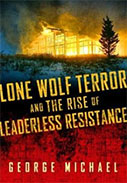Lone Wolf Terror And The Rise Of Leaderless Resistance

Author: George Michael
Publisher: Nashville, TN: Vanderbilt University Press, 2012. 264p.
Reviewer: Emma Sinclair | May 2013
The goal of this book is to impart an argument for how warfare, specifically terrorism, has evolved over the past couple of centuries into a transnational, yet fragmented construct that involves both state and non-state actors on almost equal footing. Michael begins by setting the stage nicely for the later chapter topics that outline the evolution and changes that have occurred worldwide that contribute to his central thesis: that decentralized organizations and “lone wolves” have become common and could disrupt and damage societies in ways that traditional warfare never could, using psychological tactics and new technologies.
Michael’s first chapter outlines the changing generations of warfare. Four generations of strategies, tactics, and operations began with Napoleon and the idea of nationalism, uniting entire countries in common goals. New technologies and greater state resources throughout the years advanced these tactics and abilities, leading to fourth generation warfare after WWII and the use of guerrilla wars and “revolutionary politics.”
The book then moves into more specific instances of resistance in this fourth, moving into a fifth generation, of individuals and groups, separate yet fighting for the same extremist ideologies. Specifically, Michael mentions episodes of right-wing extremism in the United States committed by unaffiliated individuals pursuing their ideologies using violence. He also discusses the formation and actions of different groups in the eco-extremism and animal rights activism movements.
The implications for various strategies of terrorist groups are discussed in light of the recent globalization and Western domination. Though the development of procedures and strategies of terrorist groups due to the changing global circumstances is a broad topic, the author does a good job incorporating many aspects (e.g. political, military, people, organizations, events, countries, etc.), isolating these issues, and discussing them.
New advances in technology have greatly increased the possibilities and options available to terrorist individuals and networks. The internet allows for instant, worldwide, decentralized communication between anyone, making the planning of attacks or the promulgation of an ideology much easier. Weapons of mass destruction (WMD) also present a distinct problem when viewed with “lone wolf” and decentralized terrorism in mind. As more advances are made, these weapons become more widespread, easier and cheaper to procure, and harder to detect.
The last chapter discusses the Islamic resistance in great detail and depth. As it is one of the most important, destructive, and pervasive terrorist groups in existence, it requires an entire chapter to discuss. Michael again does a good job of outlining the beginnings of radical Islamism and how events and the various leaders’ doctrines and teachings evolved into the decentralized organization of small cells and “lone wolves” that it has become.
In his conclusion, Michel argues that there is a fifth generation warfare that consists of an assortment of strategies, both new and old, used by state and non-state actors. His main point is that it is leaderless. While strategies of terrorists change to “lone wolf” tactics, the tools and weapons they use change as well, keeping pace with technological innovations. Michael’s thoroughly well-argued book concludes with a poignant, yet worrisome, statement, “A few angry people now have the potential to cause unprecedented destruction.” This is something that the world must keep in mind in the future.
Emma Sinclair, Graduate Student, University of Pennsylvania


